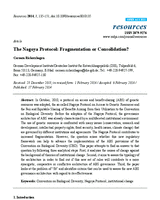The Nagoya protocol: fragmentation or consolidation?
Richerzhagen, CarmenExterne Publikationen (2014)
published on Resources 3 (1), 135-151
In October, 2010, a protocol on access and benefit-sharing (ABS) of genetic resources was adopted, the so-called Nagoya Protocol on Access to Genetic Resources and the Fair and Equitable Sharing of Benefits Arising from their Utilization to the Convention on Biological Diversity. Before the adoption of the Nagoya Protocol, the governance architecture of ABS was already characterized by a multifaceted institutional environment. The use of genetic resources is confronted with many issues (conservation, research and development, intellectual property rights, food security, health issues, climate change) that are governed by different institutions and agreements. The Nagoya Protocol contributes to increased fragmentation. However, the question arises whether this new regulatory framework can help to advance the implementation of the ABS provisions of the Convention on Biological Diversity (CBD). This paper attempts to find an answer to that question by following three analytical steps. First, it analyzes the causes of change against the background of theories of institutional change. Second, it aims to assess the typology of the architecture in order to find out if this new set of rules will contribute to a more synergistic, cooperative or conflictive architecture of ABS governance. Third, the paper looks at the problem of “fit” and identifies criteria that can be used to assess the new ABS governance architecture with regard to its effectiveness.


